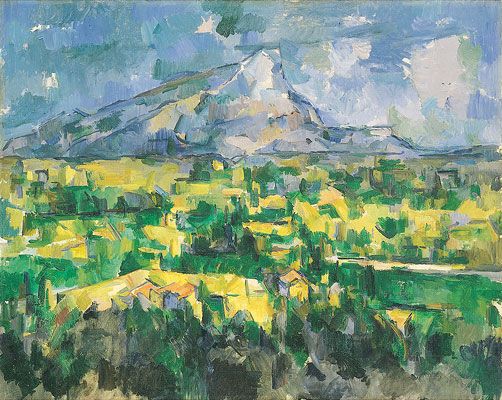Okay, so I’ve been wanting to talk about this for a while. You know, landscape paintings. I've done my fair share, but lately, I felt like I was stuck in a rut. Everything I painted started to look a bit too… predictable. Too much like a photograph, if you catch my drift. I was scrolling through some art stuff online, looking for a bit of a shake-up, and I kept coming back to Cezanne’s landscapes.
More Than Just Fruit Bowls
Now, I mostly knew Cezanne for his still lifes, those famous apples and oranges. But man, his landscapes, especially the ones he did around Aix-en-Provence, like that Montagne Sainte-Victoire he painted over and over – they really grabbed me. I’d seen them before, of course, but this time I really looked. It wasn't like any landscape painting I’d ever tried. He was chummy with Pissarro, one of the big Impressionist guys, and apparently picked up painting outdoors from him. But Cezanne, he wasn’t really an Impressionist. He was off doing his own thing, something that folks say led to Cubism and all that modern art stuff.
Getting My Head Around Those Brushstrokes
So, I thought, "Right, I’m going to try this." The first thing that really stood out to me was his brushwork. It’s all these short, kind of blocky strokes, like little patches of paint. He builds up the whole scene with these. "Easy enough," I thought. Well, let me tell you, my first attempts were a disaster. Looked like I’d just thrown paint at the canvas. His strokes are described as "exploratory," and I started to see why. It’s like he was figuring things out as he was painting, not just filling in a drawing. And he’d go over bits again and again. It takes a lot of patience, more than I thought I had.

Planes of Color and What Happened to Perspective?
Then there’s his use of color. He’d put these planes of color right next to each other to make shapes and depth. Not the smooth blending I was used to. It was more about how the colors sort of buzzed when they were side-by-side. That was a real challenge to get a feel for.
And perspective! Honestly, it felt like he just tossed the old rule book out the window. You know, how things are supposed to get smaller and fainter in the distance in a very specific way? He didn’t always stick to that. At first, it looked a bit odd, almost "wrong" to my eye. But the more I tried to copy it, and the more I looked at his work, the more I saw that his paintings had this incredible solidity, like he was capturing the actual structure of the land, not just a pretty view.
My Go at It: A Bit of a Struggle, Then a Little Lightbulb Moment
So, here’s roughly how I went about trying to paint a landscape in his style:
- I picked a fairly simple scene I knew, nothing too complicated. Figured I needed a familiar subject if I was going to wrestle with a whole new way of painting.
- Instead of a detailed sketch, I just started dabbing in big areas with those chunky brushstrokes I mentioned. Really tried to think in patches of color from the get-go.
- My main focus was on building up the forms – trees, hills, maybe a building – using these patches. It was slow going. Lots of looking at my subject, then a few dabs of paint, then more looking. My arm actually got tired!
- I kept trying to remember what I'd seen about his "planes of color," trying to make them create a sense of form and depth, even if the perspective wasn't strictly by the book.
- There were definitely moments I just wanted to give up and paint it my usual way. It felt like I was having to learn how to see all over again, which was frustrating but also kind of exciting.
One thing that eventually started to click was realizing just how intensely he must have studied what he was painting. You can feel it in his work. It’s not a quick impression; it's a deep, long look.
The Result: No Masterpiece, But I Learned a Ton
So, what did my painting look like in the end? Well, it’s not going to hang next to a real Cezanne anytime soon, let’s be honest. But it had a different kind of energy to it, something my older landscapes lacked. It felt more… constructed, if that makes sense. More about the paint and the process of building the image.

I realized that for Cezanne, it wasn't just about making a pretty picture. It was about his intense observation and how he translated the solid, three-dimensional world onto a flat canvas using his very particular methods. Those repetitive little brushstrokes, the way colors sit next to each other, that sometimes unusual perspective – it all comes together to make something really powerful and, even now, very modern-feeling.
It’s definitely changed how I approach a canvas. It’s a lot tougher than it looks, but trying to paint like him really makes you appreciate what a genius he was. If you’re a painter and feeling a bit stuck, I’d say give it a shot. It’ll definitely make you think!








